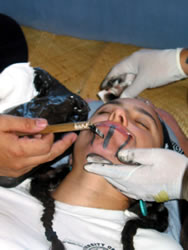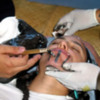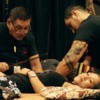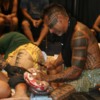Tribal members in Northern California are reclaiming traditional tattoos, especially facial tattoos as a means to connect with their cultural history, a panel of experts in indigenous tattoos told a diverse group of 45 people in attendance at the community event at the Museum of Sonoma County. Those who attended were surrounded by displays of indigenous art, ceramics, and paintings. A spectacular hand carved canoe, used for traditional voyages, tracing ancestral journeys through the Pacific Northwest was suspended from the ceiling. It was an evening of learning how ancestral memory is influencing a new generation of indigenous people.
The panelists, L. Frank Manriquez, Sage LaPeña, and Jonny Bautista explained what’s behind the revival of interest in indigenous tattoos, including the culture, their significance in a person’s life, and the meanings behind the symbols or designs. The tattoos tell a story about a person’s lineage, his or her journeys, accomplishments, or coming of age. Tattoos have to be earned or given, rather than based on personal desires. Indigenous tattooing or body markings are made with traditional tools. Each panelist spoke of the personal journey which lead them to wear indigenous tattoos.
Jonny Bautista, a core member of Balik Sa Dagat: Bangka Journey, and a student of Cinema and Asian American Studies at San Francisco State University, shared his understanding of pre-colonial traditions in the Philippines, including how archeologists found similar tattoo designs on pottery. His great-grandparents, who came from a culture that proudly embraced their heritage through tattoos, started to have a sense of shame about them. When missionaries occupied the Polynesian islands, they called the Philippines the “Island of the painted one” and said that tattoos were a representation of evil. During this time, Filipinos hid their tattoos. Today there is a resurging interest in the history of tattoos, their symbolism, how they reflect and shaped culture, and how they provide evidence of the migration patterns across the islands along the Pacific Rim.
Sage LaPeña, Wintu herbalist, ethnobotanist, teacher and medical herbalist within Indian Health Services in Northern California was mentored by an elder of the Trinity Tribe to recognize and gather medicinal plants and herbs. As a child, she spent hours everyday with her Auntie mentor in the natural areas surrounding their homeland in far Northern California. “when I talk about taking care of the earth, living with the environment, herbalism, TEK (traditional ecological knowledge), the words that I speak are the truth and come from my elders, my ancestors, from Mother Earth. So that is what is embodied in that tattoo; that is what it represents as a human being living where I do, in Northern California.” Today she proudly wears tattoos on her face, arms, back and shoulder as a way of reconnecting with her heritage, and as a way of supporting the next generation to maintain their culture and traditions.
Frank Manriquez, is a Tongva/Ajachmem artist, writer, tribal scholar, cartoonist, and indigenous language activist. Her paintings have been featured in galleries and museums nationally and internationally. L. Frank is the co-founder of Advocates for Indigenous California Language Survival and serves on the Native American Council for the Phoebe Hearst Museum of Anthropology, Berkeley. As the elder among the group, she spoke of dreaming of tattooed ancestors. Her father was sent to boarding school, where so much of the traditional customs, beliefs, and values were lost. This made the journey to where she is today very difficult. Growing up, she said, she always had a sense that something was not right. Something was missing, and these feelings lead her to want to hold hands with her grandmother and aunties through indigenous tattoos. Eventually she would come to see tattoos as a way to step forward and take her place in tribal society.
The right to wear tattoos is given to her by her community. She had not anticipated how she would be perceived publicly walking amongst non-native people wearing tattoos. It was a lonely journey, she said, so she had to take solace in herself. The tattoos L. Frank wears allow her to see things that others can’t, and with the tattoo on her left eye, she says, she can see the future.
Today, many women and men are taking back these linkages to their past, she said, including indigenous tattoos, which have tremendous spiritual, cultural and public significance. To symbolically release the burden of the losses associated with the boarding schools, these women and men rebalanced, symbolically taking song keepers, language keepers, keepers of traditions, and more out of the basket was part of the healing process. These losses were no longer being carried in their basket, she explained. For so many generations, going against these native traditions, made people sick. They eventually survived and now they are on their way to thriving.
To symbolically release the burden of the losses associated with the boarding schools, these women and men rebalanced, symbolically taking song keepers, language keepers, keepers of traditions, and more out of the basket was part of the healing process. These losses were no longer being carried in their basket, she explained. For so many generations, going against these native traditions, made people sick. They eventually survived and now they are on their way to thriving.
“We are keepers of that tribal knowledge and history,” said L. Frank. “This information is our birthright worldwide. Stand and take your place. I give this seat to you. Next time one of you will be sitting here instead of me.”




Comments (0)